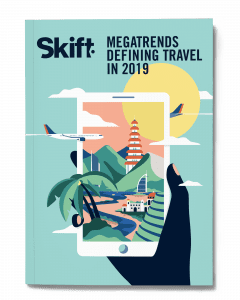Restaurant Megatrends 2019: Product Development Looks to Consumers' Micro-Feedback
Skift Take
There’s no doubt that competitive markets require businesses to continually strive to meet consumer demands if they’re to remain relevant. Companies that provide restaurant-supporting software are no exception to this rule. Incorporating consumer feedback on a micro level has proven to be a successful approach to product development.
We've just released our annual industry trends forecast, Skift Restaurant Megatrends 2019. You can read about each of the trends on Skift Table as well as download a copy of our magazine here.
In March, McKinsey published its “new rules of food and beverage innovation”, highlighting the importance of continual refinement. To “always be in beta,” companies need to be culturally “obsessed” with consumers’ needs, taking advantage of the “immediate feedback loop” e-commerce provides to “capitalize on opportunities."
Restaurant-supporting startups and established brands alike have taken this to heart by utilizing micro-feedback, bits of information frequently collected throughout a customer’s interaction with a product, service, or experience that tend to be more specific and actionable than those captured on a macro level.
Take OpenTable, a relative dinosaur in the reservation platform space whose commitment to customer satisfaction has helped to prevent its extinction. The company first began offering online reservations 19 years ago exclusively in San Francisco; now, it works with 47,000 restaurants globally. It’s needed to evolve, not only as a means of keeping up with technology, but to continue to compete with more recently established brands providing a similar service.
Accordingly, user feedback is more important than ever. The company redesigned its app earlier this year in response to users seeking more immediate reservations through the platform. Factoring in user research and both diner and employee feedback, the interface now presents two choices: “book” for those wanting to eat sooner rather than later, and “discover” for those looking to browse. Each option takes the current time of day into account to suggest the most appropriate meal.
Along the same lines as the “discover” option, OpenTable CEO Christa Quarles explained at the Skift Restaurants Forum in September that the company is “tapping its user data to create lists for users based on the habits of tastemakers” in an effort to become “more of a recommendation engine than it has been in the past, with a particular focus on appealing to travelers.”
The platform also recently made it possible for diners to select their preferred seating option, whether that’s at the bar or on the patio. And in October, OpenTable introduced GuestCenter, a means of streamlining operations and increasing bookings across restaurant groups to make it easier to offer alternatives when the exact time and location originally requested by a guest aren’t available.
Familiarity via Customization
Resy launched in New York in 2014, and hit the ground running. Its network isn’t as large as OpenTable’s (yet, anyway), as it currently works with about 10,000 restaurants, but it understand what its users want just as well, if not better. In April of this year, Resy announced its integration with Upserve, an all-in-one restaurant management platform that provides “granular insights into guest preferences — from favorite dishes and dining companions to frequency of booking — to make everyone feel like a regular,” as explained on the Resy blog.
They also introduced Resy surveys soon after, “to optimize and enhance the dining journey for customers.” The reservation-integrated product “allows restaurants to completely customize private post-meal surveys to gain insight into all aspects of their operation — from steps of service, to customer behavior, to seating and meal preferences.
Every survey is tied to a reservation, supplying the restaurant with meaningful, useful and actionable insights from the customer.” And, to address a customers’ desire for instant gratification in a different way than OpenTable, Resy also allows diners to book tables directly through both participating restaurants’ Instagram profiles, and Google.
Consumer micro-feedback has influenced third-party delivery services, too. To address the desires of diners who wanted a no-fee option, DoorDash began offering in-person order pickup in August. Uber Eats modified its delivery fees that same month, replacing the previously flat fee with a pricing tool that calculates costs based on customers’ proximity to the restaurants they order from.
And when Grubhub closed its acquisition of LevelUp in September, Grubhub founder and CEO Matt Maloney explained it was with the intention of helping “restaurants actively engage with their diners,” surely recognizing the value in doing so. When customers’ needs are part of product development, all associated parties have the potential to better achieve desired outcomes.
Download Your Copy of Skift Megatrends 2019

Skift Table contributor Ally Spier is a Brooklyn-based writer and designer who studied ergonomics at Cornell, and architecture at Pratt. Her background in design informs her love of food and travel… and vice versa.

The travel industry's top event returns this fall.
September 16-18, 2025 - NEW YORK CITY

